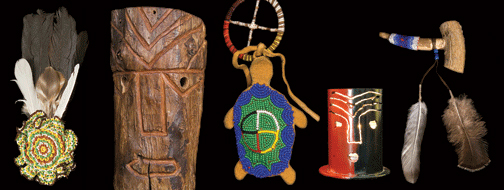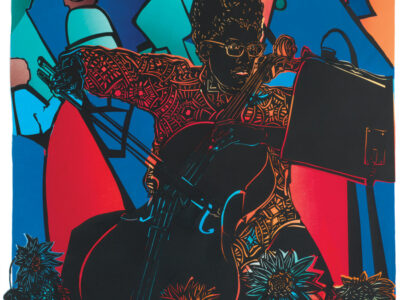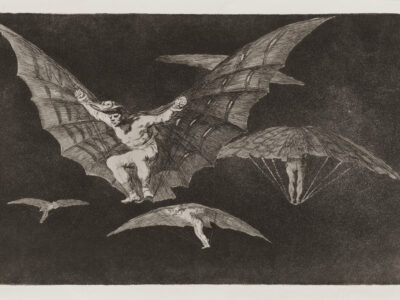
While most of her peers sunbathed, trekked through Europe, or played catch-up with the television this summer, Abigail Seldin C’09 G’09 was exploring an unwritten history—and making some history of her own in the process.
Seldin will become the first undergraduate student to curate an exhibit at Penn’s Museum of Archaeology and Anthropology when Fulfilling a Prophecy: The Past and Present of the Lenape in Pennsylvania opens on September 13.
Of all the Native American tribes whose displacements have been chronicled through the years, why focus on the Lenape, a group that virtually disappeared from Pennsylvania history after the 18th century? The “official” story, that all Lenape left the area, was unsettling to Seldin, who is majoring in anthropology while simultaneously pursuing a master’s degree in the field. And like any good anthropologist, she had to find out the truth.
“All of the books I read about Lenape history stated simply that the Lenape had left Pennsylvania en masse in the late 1700s,” she says. “As it happens, there were people who stayed behind. Their story has just never been told.”
Chief Robert Ruth of the Lenape Nation of Pennsylvania echoes that thought. “It’s a rich and real history that not even our neighbors know,” he says. “We want people to know that we are proud of our history. You may not know that, as you’re passing Manayunk, Perkiommen, and Conshohocken, you’re speaking Lenape. It is a history that is of the land—it is in the land. We want to get our story out and help people understand our common history.”
The story goes like this: The Lenape once lived in an area stretching from Connecticut to Delaware. In the 17th century, they had their first contact with European traders. Colonists pushed them off their lands gradually until 1737, when the sons of William Penn, desperate to pay off debts, produced a “lost treaty” with the Lenape that dated back to the 1680s. This disputed document stated that the Lenape had ceded a parcel of land beginning at the junction of the Delaware and Lehigh rivers and extending “as far west as a man could walk in a day and a half.” To carry out this measurement, Provincial Secretary James Logan enlisted three athletes to sprint from the starting point and claim as much land as possible, having already cleared a smooth path through the wilderness. Their vigor was such that the best runner finished 70 miles from the start, representing a haul of over 1,200 square miles. Attempts to challenge the “Walking Purchase,” as this land swindle became known, went unfavorably for the Lenape, and the Iroquois Confederation helped the colonists uphold the transaction.
Facing widespread discrimination and persecution, the Lenape were forced to abandon their homes in eastern Pennsylvania, trekking as far as Ohio, Oklahoma, Canada, and Wisconsin, among other destinations. Two decades later, some of them returned to help the French fight the British during the French and Indian War.
After that, the Lenape’s Pennsylvania story gives way to an intermission lasting two centuries. Societal pressures and tainted memories forced those who stayed either to intermarry within farming communities or to remain isolated and hidden. It was this decision to hide, as well as the fact that Lenape nations are recognized in other states, that led to the misperception of the Lenape’s disappearance from Pennsylvania. To this day, a legacy of secrecy pervades Pennsylvania’s Lenape, some of whom contributed artifacts to the exhibition under the cover of anonymity.
The Lenape are also beginning to lose their language, particularly among the younger generation, a development that troubles Chief Ruth.
In February of 2007, Seldin accompanied Museum personnel delivering a traditional paddle to the Lenape Nation of Pennsylvania at a Maple Ceremony in the Pocono Mountains. There, she was able to communicate with many members of the tribe. Perhaps uplifted by the repatriation one of their historical artifacts, they began to tell Seldin their stories. Though her project had started out as a chronicle of the Lenape’s dispersal from the region, Seldin soon shifted her focus to those who stayed behind, maintaining their traditions in secret for generations.
For Seldin, who had already participated in two class-curated exhibitions, Fulfilling a Prophecy is special because of the extent of the Lenape’s involvement. Chief Ruth and former tribal secretary Shelley DePaul are serving as co-curators with Seldin, and representatives from the tribe will be on hand during the exhibit to talk about certain traditions and artifacts and their place in Lenape culture. This keeps the show from becoming too “voyeuristic,” Seldin says.
“Many exhibits include Native Americans only in a consultant capacity, limiting their ability to shape the project,” she explains. “This exhibit is different, because the Native Americans involved have equal decision-making capacity within the project. We act as a team of equals, rather than as an anthropologist with informants.”
Seldin was able to foster these relationships by sharing her own cultural history. “My first meeting with my co-curators took place just before Purim,” she recalls, referring to the Jewish holiday. “I was nervous, so I baked hamantashen and brought it along to break the ice. Shelley was particularly interested in the shape of the cookies, and asked if the triangular shape held any significance. So I told them the story of Purim, which is essentially the story of a woman trying to save her people from extermination. The Lenape have had a hard history, and I think she and Bob both appreciated that I came from a background that enabled me to understand that viscerally, rather than intellectually.”
To each subsequent meeting, Seldin brought something else to share. Slowly the bond began to strengthen. “Our project has been about sharing, and cross-cultural exchanges, rather than a series of one-way anthropological interviews,” she says.
Fulfilling a Prophecy has a two-pronged mission: to reintroduce the Lenape to their neighbors and vice versa, and to serve as a case study of how to involve Native Americans in the curatorial process. The exhibit’s name refers to the Lenape “Prophecy of the Fourth Crow.” The four crows represent different periods of Lenape history: from creation to the first contact with European traders, through the era of mistreatment and exile, and into the modern day. Chief Ruth credits Seldin as the fulfillment of the fourth prophecy, wherein the Lenape are able to rejoin society as proud members of an ancient heritage.
“We really feel that Abby was sent to us in fulfillment of the prophecy.” Ruth says. “She has been very warm and professional, very open and forthright. She has attended our tribal council meetings and everyone is always impressed.”
—Carter Johns C’07
“Fulfilling a Prophecy” opens with a public celebration at the Penn Museum on September 13 from 1-4 p.m. In conjunction with the opening, the Association of Native Alumni is co-sponsoring a reception for alumni, students, and Lenape representatives in the Nevil classroom from 3:30-4:30 p.m. Alumni are asked to RSVP at http://www.alumni.upenn.edu/ana/events.html.




